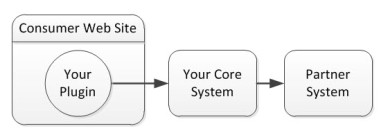In my last article, I described a technique for extending traditional dealer functions into the consumer space. I used the metaphor of a land rush, with the extension feature claiming territory on one or more consumer web sites. This is part of a generic strategy, to update any dealer system and make it more relevant to the evolving world of online auto retail.
In this post, we will survey the consumer space, looking for opportunities to insert the various dealer system extensions. My plan is not to predict the future of online retail, but to show where these “plug-ins” may be placed today. Prediction only comes into play because we want to know how durable the relationship will be.
Sunnyvale Toyota is one of many individual dealer sites featuring the eLEND credit plug in. If you’re not clear on the plugin concept, take a look. Technically, this is an Iframe that passes control to the extranet formerly known as Dealer Centric. The site itself is by Dealer.com, and the dealer has chosen to delegate the credit process to eLEND.
I really like this technique, but that’s not the question. Credit systems are well represented on dealer sites, using a variety of techniques. The question is – where are the protection products? Pricing and presenting products on a dealer site is technically easier than doing a credit app. This is an obvious place to extend menu systems and provider networks.
A dealer site is not a good place to start desking, because the site is too far down funnel, and the process depends too much on pricing. A key advantage for the dealer’s desking system is the ability to include local taxes, fees, and incentives. We’ll talk later about how and why desking should be part of the customer’s online shopping experience.
A dealer site is also not a good place for opt-in CRM or, at least – as I wrote last week – not as good as an OEM site. People move around too much. Another thing to consider with dealer sites is that they will increasingly be dominated by shopping sites and consolidators.
You would think that specialist car shopping sites would offer the most functionality to their customers – and you would be wrong. That’s because they don’t own the inventory, and they don’t control the process at the dealership. It’s hard to initiate a credit app or sell a service contract on behalf of a heterogeneous dealer population. Auto Trader offers a link to a direct lender.
Even consolidator sites, like Sonic and AutoNation, leave the heavy lifting to their stores. They are better able to standardize process and systems than the other shopping sites, but they still have to work with different franchises and different captives. There is opportunity here for dealer systems to differentiate themselves by offering consumer-site features.
You would think that specialist car shopping sites would offer the most functionality to their customers – and you would be wrong.
Used car consolidators, like CarMax and Vroom, have much more flexibility. It is theoretically possible for these sites to offer a complete buying experience online. To me, that includes credit, desking, and products. Vroom wants to be “the Zappos of online car buying.” This brings me to that futurism topic I promised to avoid, and our next category … car buying sites.
I like to make a distinction between shopping sites and buying sites. Shopping is a nonlinear process, with rough ideas and estimates. Just look at all those asterisks on the shopping sites. Buying requires things to be done in a certain sequence, with exact values.
A shopping site is all about selecting and pricing a vehicle from inventory, and then turning over the lead. This means a variety of dealers with a variety of systems, and little opportunity to extend functionality toward the customer.
They may say “buy a car online,” but very few actually attempt a complete buying process. Vroom and ShopClickDrive are exceptions. Both use Route One for credit processing – and nothing for protection products. Buying sites, as they evolve, will be the Promised Land for dealer system extensions.
I was going to make a separate category for research sites, like Edmunds and TrueCar. For our purposes, these are the same as shopping sites, above.
Calculators and credit apps abound on the auto finance sites, and some of them are quite good. This is where you can “roll to amount financed,” for example, with current loan rates. I see untapped potential here, for desking, CRM, and product links. Plus, here’s an out-of-the-box idea – an inventory search plugin for the banks. It would look something like this, below. Bank of America already has the window. It’s just missing the car!
I include OEM sites even though they’re poor candidates for dealer system extension. The challenge with OEM sites is that they already have proprietary relationships with F&I partners. The Buick site takes you right to Santander, and the products on the Hyundai site are from Safe-Guard. Also, an OEM must consider all their dealers, so they can’t favor one system over another.
Your best bet here is to develop a generic interface, and then compete on the depth and breadth of your OEM integration. Dealer Track does this in the service department. If you know of anybody doing it in the front office, please let me know.
The table below summarizes the opportunity for extending dealer systems into the consumer space. There is no “official” taxonomy of auto retail sites. I chose these categories because they work well with the generic strategy.
Whether you are planning a strategic move into the consumer space, or just a new feature, I hope you find my analysis useful. You can’t beat the land rush if you don’t have a map.





